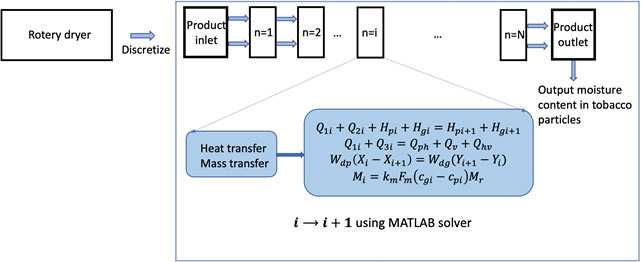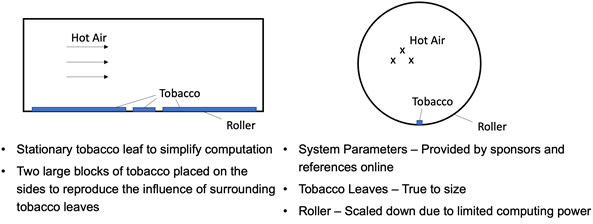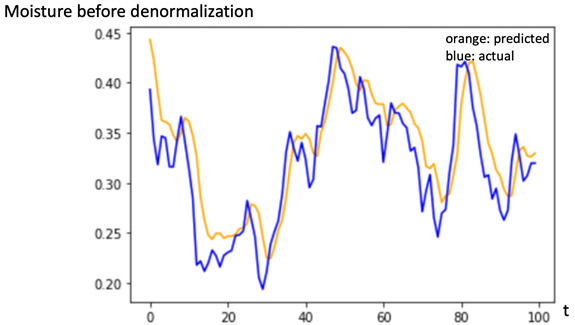Student Projects
VE/VM450

Creating Digital Twin Models for Tobacco Drying Processes
Team Members: Shiyu Liu, Mengtian Guo, Lejun Jiang, Tianchun Huang, Jingyu Su
Instructor: Prof. Shouhang Bo
Project Video
Team Members

Team Members:
Shiyu Liu
Mengtian Guo
Lejun Jiang
Tianchun Huang
Jingyu Su
Instructor:
Prof. Bo Shouhang
Project Description
Problem Statement
The drying process in tobacco industry is rarely explored from a theoretical perspective, and it mostly relies on empirical parameter study through trial and error. Under most situations, manual control induces quality fluctuation and more energy consumption. Therefore in this project, we aim to create digital twin models of the tobacco drying process, which will set a foundation of drying process optimization in tobacco industry.
![Fig. 1 Sample image of a rotary dryer for industrial usage [1]](https://www.ji.sjtu.edu.cn/wp-content/uploads/2020/07/450-2-pic01.jpg)
Fig. 1 Sample image of a rotary dryer for industrial usage [1]
Concept Generation
We approach to the modeling task from three directions: physical principles, finite element analysis, and machine learning. The concepts are generated separately for each method by decomposing the problem to several sub-concepts that lead to the design solution.

Fig. 2 Physical principles-based modeling with discretization

Fig. 3 Learning-based modeling

Fig. 4 Finite element analysis
Design Description & Analysis
Physical principle-based modeling:
The discretize computing process is implemented using Matlab. We put data acquired at the inlet section of the rotery dryer to solve for the intermediate states of the tobacco particles in a stepwise manner, following the heat & mass transfer principles. The last-step output will be the predicted outlet tobacco moisture content.
Finite element analysis:
Due to the limitation imposed by the FEA method itself and the computation resources, we made a major simplification to the simulation to keep the tobacco leaves stationary and pass hot air through the drum and to shrink the size of the rotary dryer. With an understanding of the system physics, we propose 4 physics modules to simulate the dynamics inside the drying process. They are coupled with the parameters and physical quantities obtained through a provided dataset, sponsors and online sources to complete the final COMSOL model design.
Data-driven modeling:
We design a model that can predict the output moisture content at the next timestamp given any timestamp with its previous outputs and parameters. The metric we use to evaluate the model is the average relative error between the predicted outputs and actual outputs from test datasets.

Fig. 5 Predicted moisture content vs. actual moisture content
Validation
Validation Process:
We validate our models separately for different methods. For each input of the provided dataset, our model will be able to calculate a predicted output tobacco moisture. We then compare the predicted value with the actual moisture content in tobacco particles. The resulting relative error is the primary criteria for evaluating the performance of the model.
Another way to validate our model is by data visualization. Plotting both the actual and predicted moisture content in the plot and comparing their trends of change enable us to observe whether our model can capture variation tendency properly.
Validation Results:
According to Fig. 5, our model can give reliable prediction of the tobacco moisture.
√ Relative error of data driven model<=0.1%
• Relative error of first-principle model and FEA<=10%
• Time for data processing<= 30min
√ means having been verified and · means to be determined.
Conclusion
Our project aims to create digital twin models for the tobacco drying process, a task rarely explored by either the industry or the academia. Referring to the existing related work, we propose three methods to approach the problem. The manufacturing and validation plans are set up regarding to the proposed design decomposition and the resource we have.
Acknowledgement
Sponsor: Ziqi Zhu from AIMS
Shouhang Bo UM-SJTU Joint Institute
Reference
[1] https://feeco.com/photo-gallery/
